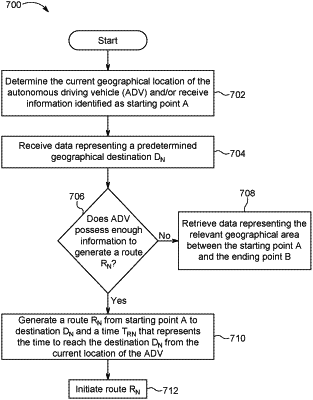| CPC G01C 21/3453 (2013.01) [G05D 1/0088 (2013.01); G05D 1/0212 (2013.01); G06V 20/597 (2022.01); G08G 1/096827 (2013.01); G05D 2201/0213 (2013.01)] | 17 Claims |

|
1. A system, comprising:
one or more sensor devices configured to generate sensor data;
a memory; and
one or more processors, wherein at least one of the one or more processors is programmed to:
determine a first route to a first predetermined destination;
autonomously navigate a vehicle along the first route towards the first predetermined destination;
receive the sensor data from at least one of the one or more sensor devices;
wherein, in response to detection of an event based at least in part from the sensor data received from at least one of the one or more sensor devices, the at least one of the one or more processors are further programmed to:
determine a type of event associated with the event based at least in part on the sensor data;
determine a current geographical location of the vehicle;
determine a first distance x from the current geographical location of the vehicle;
request mapping information that includes a first geographical area that measures the first distance x from the current geographical location of the vehicle;
identify a first set of one or more geographical artifacts within the first geographical area that includes a geographical location of the one or more geographical artifacts in the first set;
determine a first set of routes from the current geographical location of the vehicle to the geographical location of at least one of the one or more geographical artifacts;
automatically determine if the geographical location for the at least one of the one or more geographical artifacts resides at a distance from the current geographical location of the vehicle that is greater than a predetermined maximum safety distance; and
select a first geographical artifact of the first set of the one or more geographical artifacts based at least in part on the type of event and the predetermined maximum safety distance.
|